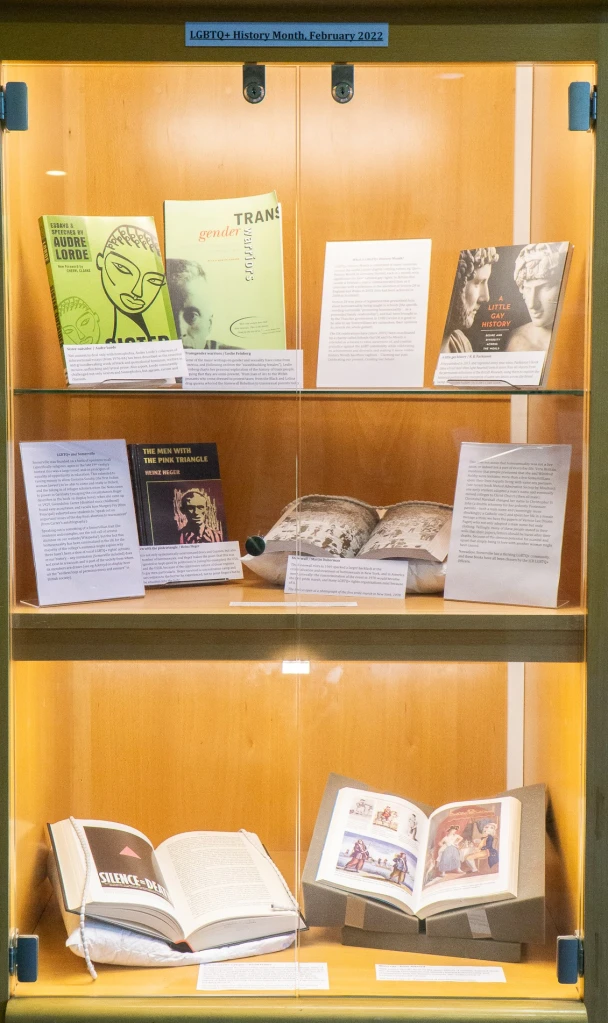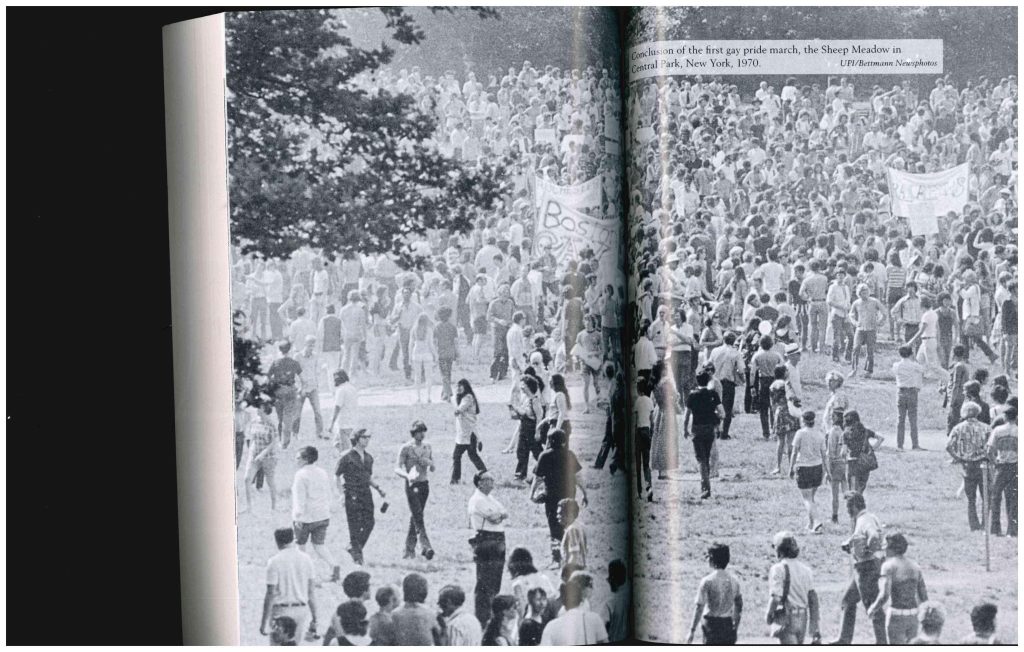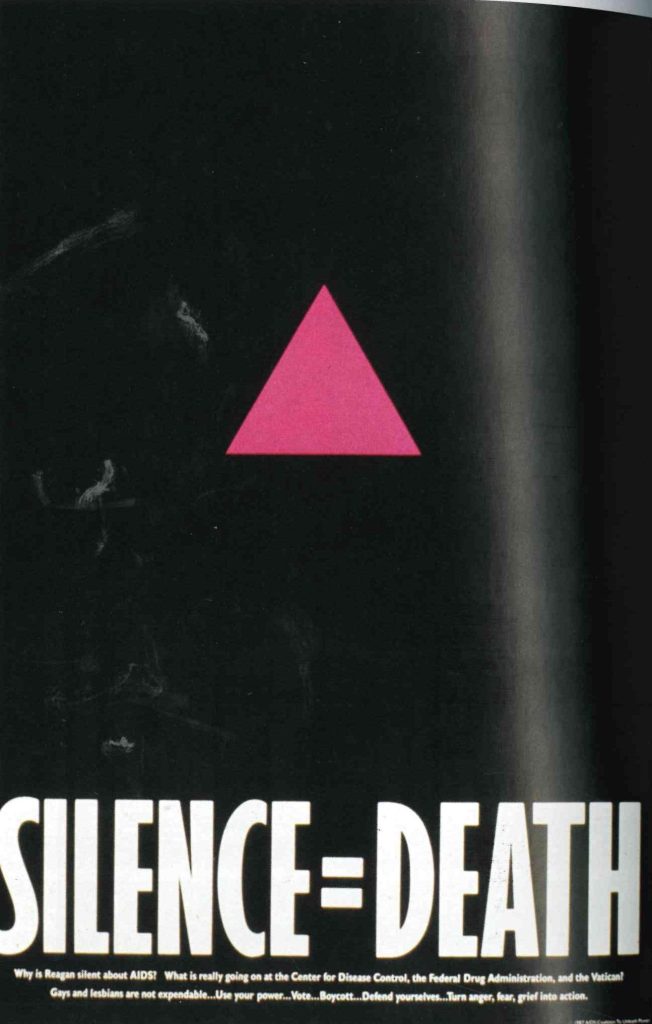Past exhibition
Loggia Exhibition February 2022
LGBTQ+ History month

LGBTQ+ and Somerville
Somerville was founded on a basis of openness to all (specifically religious – in the late 19th century this was a large issue) and on principles of equality of opportunity in education. This extended to raising money to allow Cornelia Sorabji (the first Indian woman lawyer) to be able to come and study in Oxford, and the taking in of refugee scholars when the Nazis came to power in Germany (escaping the circumstances Heger describes in the book on display here); when she came up in 1929, Gwendolen Carter (disabled since childhood) found easy acceptance, and recalls how Margery Fry (then Principal) exhorted new students to “speak out on important issues of the day from abortion to rearmament” (from Carter’s autobiography).
Speaking out is something of a Somervillian trait (for evidence and examples, see the roll-call of activist alumnae on our website/Wikipedia!), but the fact that homosexuality has been criminalized in the UK for the majority of the college’s existence might explain why there hasn’t been a slew of vocal LGBTQ+ rights’ activists in our history – any institution (Somerville included) does not exist in a vacuum and is part of the society from whom its members are drawn (see eg Ackroyd on display here on the “endless loop of permissiveness and censure” in British society).
This does not mean that homosexuality was not a live issue, or indeed not a part of everyday life: Vera Brittain mentions that people presumed that she and Winifred Holtby were lesbians; more than a few Somervillians spent their lives happily living with same sex partners (see recent book Mutual Admiration Society by Moulton); one early student adopted a man’s name and eventually moved colleges to Christ Church (then all male); Christabel Marshall changed her name to Christopher St John (a double whammy for her ardently Protestant parents – both a male name and (seemingly more shockingly) a Catholic one!) and spent her life in a female menage a trois; we have the papers of Vernon Lee (Violet Paget) who not only adopted a male name but male clothing. Tellingly, many of these people stated in their wills that their papers/letters should be burnt after their deaths, because of the obvious potential for scandal and upset that simply being in love with another woman might have caused.
Nowadays, Somerville has a thriving LGBTQ+ community, and these books have all been chosen by the JCR LGBTQ+ Officers.
What is LBGTQ+ History Month?
LGBTQ+ History Month is celebrated in many countries around the world (under slightly varying names, eg. Queer History Month in Germany/Berlin), each in a month with significance for local national gay rights. In Britain this month is February, and is commemorated then as it coincides with a milestone in the abolition of Section 28 in England and Wales in 2003 (this had been achieved in 2000 in Scotland).
Section 28 was piece of legislation that proscribed facts about homosexuality being taught in schools (the specific wording surrounds “promoting homosexuality … as a pretended family relationship”), and had been brought in by the Thatcher government in 1988 (whilst it is good to be able to say Somervillians are outspoken, their opinions do stretch the whole gamut).
The UK celebrations have (since 2005) been coordinated by a charity called Schools Out UK and the Month is intended as a means to raise awareness of, and combat prejudice against the LGBT community while celebrating its achievement and diversity and making it more visible. History Month has three taglines – ‘Claiming our past. Celebrating our present. Creating our future’.
The display includes books from our current lending collection on broader history and issues surrounding LGBTQ+ people and rights, ranging from the proto-historical to the twentieth century and after, and hopefully providing perspectives from different parts of the LGBTQ+ community.
A little gay history / R. B. Parkinson
First published in 2013, and reprinted every year since, Parkinson’s book takes a brief (and often light-hearted) look at more than 40 objects from the permanent collections of the British Museum, using them to explore the historical portrayal and conception of same-sex desire across the broad sweep of recorded history (ie. it isn’t a new issue).

Queer city / Peter Ackroyd
With a more specific focus on the queer history of London, Ackroyd charts the changing environment and attitudes toward homosexuality and transgression from the Romans onwards: the “endless loop of permissiveness and censure”.
The book is open at “A panorama of swashbuckling females…”

Transgender warriors / Leslie Feinberg
Some of the major writings on gender and sexuality have come from America, and (following on from the “swashbuckling females”), Leslie Feinberg charts her personal exploration of the history of trans people, arguing that they are omni-present, “from Joan of Arc to the Welsh peasants who cross-dressed to protest taxes; from the Black and Latina drag queens who led the Stonewall Rebellion to transsexual parents today”.
The men with the pink triangle / Heinz Heger
The Nazis not only systematically exterminated Jews and Gypsies, but also a large number of homosexuals, and Heger makes the point that this was largely ignored or kept quiet by politicians in (using his examples) the USA, the UK and the USSR, because of the oppressive nature of those regimes towards gay men particularly. Heger survived a concentration camp and here bears witness to the horror he experienced, not to point fingers but to bring the situation into the light.
Stonewall / Martin Duberman
The Stonewall riots in 1969 sparked a larger backlash at the criminalization and treatment of homosexuals in New York, and in America more generally: the commemoration of the event in 1970 would become the first pride march, and many LGBTQ+ rights organizations exist because of it.
The book is open at a photograph of the first pride march in New York, 1970.

How to survive a plague / David France
As Duberman tells the story of the Stonewall riots, France tells the story of the AIDS epidemic, weaving together the stories of dozens of sufferers and activists who, “grabbed the reins of scientific research to help develop the drugs that turned HIV from a mostly fatal infection to a manageable disease”. Like Randy Shilts’ And the band played on (also in the library collection), the book is intimate and often brutal, making very clear the impact of AIDS and the lack of action taken by governmental agencies to do anything about it.
The book is open at a reproduction of a poster from the 1986 US election campaign (complete with pink triangle, as referred to by Heger)

Sister outsider / Audre Lorde
Not content to deal only with homophobia, Audre Lorde’s collection of intersectional essays (from 1976-84) has been described as the essential and groundbreaking work of black and postcolonial feminism, written in incisive, unflinching and lyrical prose. Also a poet, Lorde consistently challenged not only sexism and homophobia, but ageism, racism and classism.